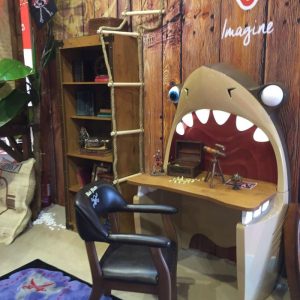Creating a Fun and Functional Space for Kids: The Best Furniture Options
Introduction: The Importance of Creating a Fun and Functional Space for Kids
Designing a space that is both fun and functional for kids is essential for their overall well-being and development. A well-designed kids’ room can provide a safe and stimulating environment where children can play, learn, and grow. It is a space where they can express their creativity, explore their interests, and feel comfortable and secure. By creating a space that is tailored to their needs and preferences, parents can foster their child’s imagination, independence, and sense of self.
A well-designed kids’ room offers numerous benefits. It can promote organization and responsibility as children learn to keep their belongings in order. It can also enhance their cognitive skills as they engage in imaginative play and problem-solving activities. Additionally, a thoughtfully designed space can contribute to a child’s emotional well-being by providing them with a sense of ownership and personal space. Overall, creating a fun and functional room for kids is an investment in their happiness, development, and overall quality of life.
Choosing the Right Furniture for Your Child’s Room: Tips and Tricks
When selecting furniture for your child’s room, there are several factors to consider. First and foremost, prioritize safety. Look for furniture that is sturdy, durable, and free from any sharp edges or small parts that could pose a choking hazard. Additionally, consider the size of the furniture in relation to the size of the room. Opt for pieces that are appropriately scaled to fit the space without overwhelming it.
Another important consideration is functionality. Choose furniture that serves multiple purposes to maximize the use of space. For example, select a bed with built-in storage drawers or a desk with shelves for books and supplies. This will help keep the room organized and clutter-free.
In terms of style, involve your child in the decision-making process. Allow them to choose colors or themes that reflect their interests and personality. This will help create a sense of ownership and pride in their space. However, keep in mind that children’s tastes can change quickly, so opt for furniture that can easily be updated or repurposed as they grow.
The Best Bed Options for Kids: From Bunk Beds to Loft Beds
When it comes to selecting a bed for your child’s room, there are several options to consider. Bunk beds are a popular choice for siblings or for rooms with limited space. They provide two sleeping areas while only taking up the floor space of one bed. However, it is important to ensure that bunk beds are equipped with safety features such as guardrails and sturdy ladders.
Another option is a loft bed, which elevates the sleeping area and creates additional space underneath. This space can be used for a desk, play area, or storage. Loft beds are particularly beneficial for small rooms where maximizing floor space is essential.
For younger children, toddler beds or twin beds with safety rails are a suitable choice. These beds provide a sense of security and prevent accidental falls during the night. As children grow older, they may transition to a full-size bed or even a daybed, depending on their needs and preferences.
When selecting a bed for your child’s room, consider their age, size, and sleeping habits. It is also important to choose a mattress that provides adequate support and comfort.
Storage Solutions for Kids’ Rooms: Maximizing Space and Minimizing Clutter
Storage is a crucial element in any kids’ room. It helps keep the space organized and minimizes clutter, making it easier for children to find and put away their belongings. There are several storage solutions that can maximize space and create a tidy environment.
One option is to utilize vertical space by installing shelves or bookcases on the walls. This not only provides storage for books and toys but also adds visual interest to the room. Another option is to incorporate storage bins or baskets that can be easily accessed and moved around. These can be placed under the bed, on shelves, or in a designated play area.
For smaller items such as art supplies or small toys, consider using clear plastic containers with labels. This makes it easy for children to find what they need and encourages them to put things back in their designated place.
Additionally, consider furniture pieces that offer built-in storage options. For example, select a bed with drawers underneath or a desk with shelves and drawers. This will help maximize space and keep the room organized.
Playtime Essentials: The Best Play Tables, Chairs, and Toy Storage
Playtime is an essential part of a child’s development. It promotes creativity, imagination, and social skills. When designing a kids’ room, it is important to incorporate playtime essentials that are both fun and functional.
A play table is a versatile piece of furniture that can be used for various activities such as arts and crafts, puzzles, and board games. Look for a table that is sturdy and easy to clean. Consider one with built-in storage compartments for art supplies or game pieces.
Chairs are another important element of a play area. Opt for chairs that are comfortable and appropriately sized for your child. Look for chairs that are lightweight and easy to move around so they can be easily rearranged for different activities.
Toy storage is crucial for keeping the room organized and minimizing clutter. Consider using open shelves or cubbies that allow children to see and access their toys easily. Alternatively, use storage bins or baskets that can be labeled and stacked on shelves or under the bed.
When selecting playtime essentials, involve your child in the decision-making process. Allow them to choose colors or themes that reflect their interests and preferences. This will make the space feel more personal and inviting.
Creating a Study Space: Desks, Chairs, and Bookcases for Kids
A study space is essential for children as they grow older and begin to take on more academic responsibilities. It provides a dedicated area where they can focus on homework, reading, and other educational activities. When creating a study space in your child’s room, consider the following elements: desks, chairs, and bookcases.
A desk should be sturdy and spacious enough to accommodate a computer or laptop, books, and writing materials. Look for a desk with built-in storage options such as drawers or shelves. This will help keep the workspace organized and minimize distractions.
A comfortable chair is crucial for promoting good posture and concentration during study sessions. Look for a chair that is adjustable in height and provides adequate back support. Consider one with wheels for easy mobility.
Bookcases are essential for storing books, reference materials, and school supplies. Look for a bookcase that is sturdy and has adjustable shelves to accommodate different sizes of books. Consider one with a combination of open shelves and closed cabinets to provide both display space and hidden storage.
When creating a study space, ensure that it is well-lit with appropriate task lighting. Consider adding a bulletin board or whiteboard for notes and reminders. Personalize the space with motivational quotes or artwork to inspire your child’s learning.
Decorating with Color and Style: Choosing the Right Furniture for Your Child’s Personality
Incorporating your child’s personality into their room design is an important aspect of creating a space they will love. By selecting furniture that reflects their interests and style, you can create a room that feels personal and inviting.
When choosing furniture, consider your child’s favorite colors or themes. For example, if they love animals, consider incorporating animal-themed bedding or wall decals. If they have a favorite hobby or sport, consider incorporating elements related to that interest.
When it comes to color, consider using a neutral base color for larger furniture pieces such as beds or dressers. This will provide a timeless and versatile backdrop that can easily be updated as your child’s tastes change. Add pops of color through accessories such as bedding, curtains, or rugs.
Consider involving your child in the decision-making process. Take them shopping with you and allow them to choose furniture or accessories that they love. This will help create a sense of ownership and pride in their space.
Safety First: How to Choose Furniture that Meets Safety Standards
When selecting furniture for kids’ rooms, safety should always be a top priority. Children are naturally curious and prone to accidents, so it is important to choose furniture that meets safety standards and is free from any potential hazards.
Look for furniture that is sturdy and stable. Avoid pieces with sharp edges or corners that could cause injury. Check for any loose parts or hardware that could pose a choking hazard.
When it comes to cribs or toddler beds, ensure that they meet the current safety standards set by organizations such as the Consumer Product Safety Commission (CPSC). This includes features such as slat spacing, mattress height adjustment, and the absence of drop-side rails.
For bunk beds or loft beds, ensure that they have proper guardrails and sturdy ladders. The guardrails should be at least five inches above the mattress surface to prevent falls.
Additionally, consider furniture that is made from non-toxic materials and finishes. Look for products that are certified by organizations such as Greenguard or have been tested for harmful substances.
Budget-Friendly Options: Affordable Furniture for Kids’ Rooms
Designing a kids’ room can be a costly endeavor, but there are budget-friendly options available that still offer quality and style. When shopping for affordable furniture, consider the following tips:
– Look for sales or discounts: Many furniture stores offer regular sales or promotions. Keep an eye out for these opportunities to save money on your purchases.
– Consider second-hand or thrifted furniture: Thrift stores, consignment shops, or online marketplaces can be great sources for affordable furniture. Look for gently used pieces that can be cleaned or refurbished to fit your child’s room.
– Opt for modular or multi-purpose furniture: Furniture that serves multiple purposes can be a cost-effective option. For example, a bed with built-in storage drawers eliminates the need for a separate dresser.
– DIY or repurpose: Get creative and consider DIY projects or repurposing existing furniture. A fresh coat of paint or new hardware can transform an old piece into something new and stylish.
– Shop online: Online retailers often offer a wider range of options and competitive prices. Take advantage of online shopping to compare prices and find the best deals.
Remember, affordability should not come at the expense of safety or quality. Always prioritize safety standards and choose furniture that is durable and well-made.
Conclusion: Creating a Space Your Child Will Love for Years to Come
Designing a fun and functional space for kids is an investment in their happiness, development, and overall well-being. By considering factors such as safety, functionality, and style, parents can create a room that reflects their child’s personality and provides them with a space to play, learn, and grow.
When selecting furniture for kids’ rooms, it is important to prioritize safety by choosing sturdy and durable pieces that meet safety standards. Consider furniture that serves multiple purposes to maximize space and minimize clutter. Involve your child in the decision-making process to create a room that feels personal and inviting.
Remember, creating a space your child will love for years to come is an ongoing process. As they grow and their interests change, be open to updating and refreshing the room to reflect their evolving personality. Start designing your child’s dream room today and watch as they thrive in their fun and functional space.

